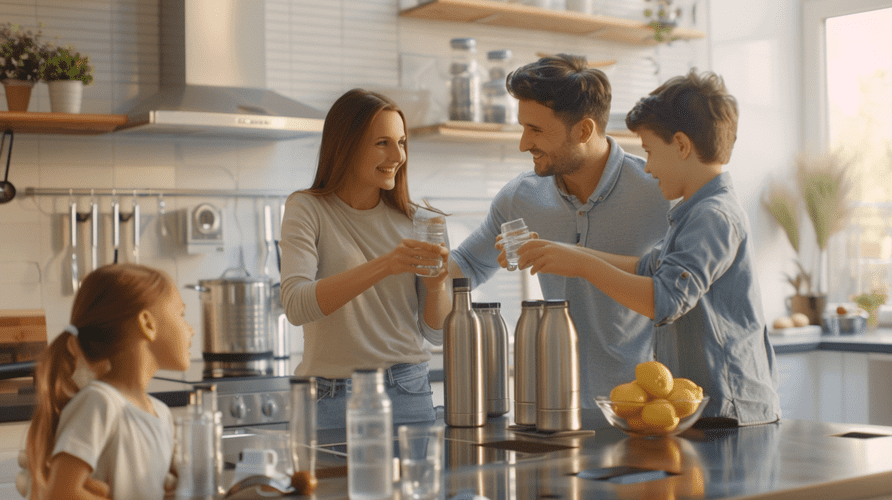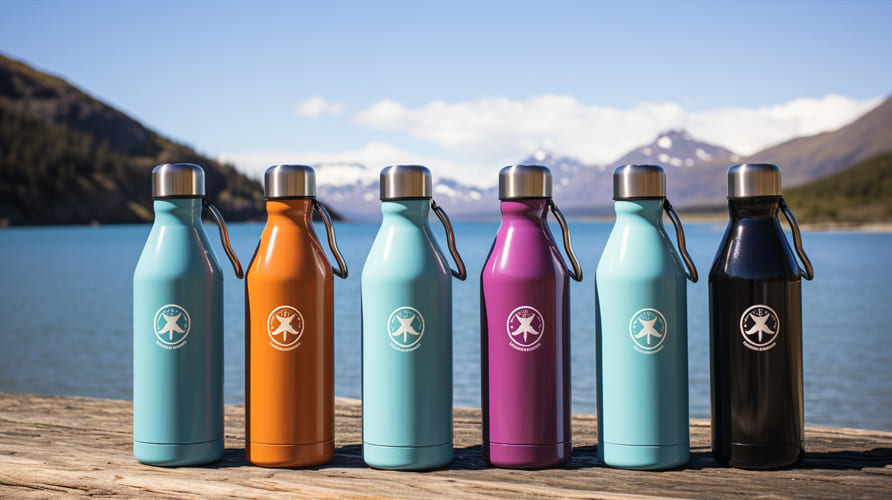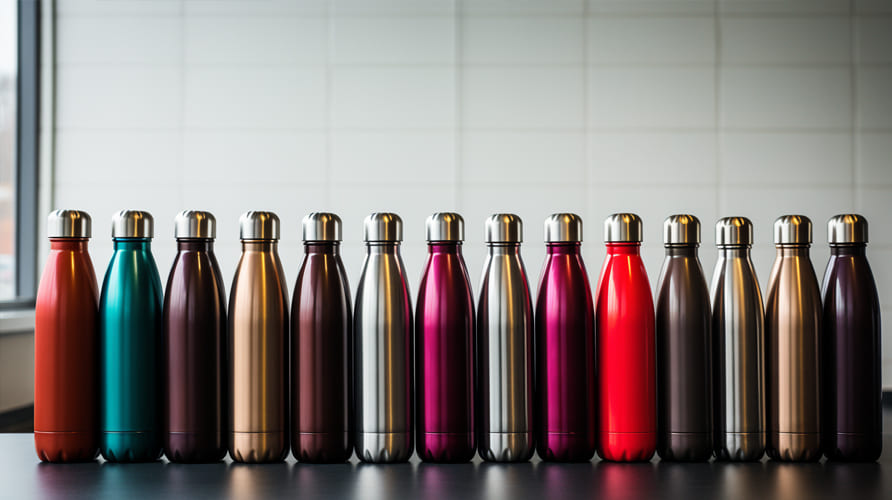Worried about what's really in your insulated bottle? Hidden chemicals or fake claims can be concerning. Understand the real guarantees for a safe bottle in 2025.
Guarantees for a safe, BPA-free, and lead-free bottle come from using high-quality materials like food-grade stainless steel, independent third-party testing, verified certifications (like FDA, LFGB), and transparent manufacturing processes from a trusted supplier.

Knowing the basics is good, but you probably have more specific questions. Let's break down what makes a bottle truly safe, starting with the materials themselves. Keep reading to find the answers you need.
What is the safest water bottle to drink from?
Choosing a bottle feels complex? So many materials, so many claims. Worried about making the wrong choice? Let's find the safest option for daily hydration.
Food-grade stainless steel, specifically types like 18/8 (also called 304)1, is widely considered the safest material. It's strong, doesn't react with drinks, resists leaching chemicals, and doesn't usually need an internal liner.

Why Stainless Steel Stands Out
When we talk about safety, the material touching your drink is most important. I work with stainless steel every day here at Icobottle, and there are good reasons it's preferred by many buyers, including those like Mark who need reliable quality for their brand. Food-grade stainless steel2, like the 18/8 (or 304 grade) we use, is very stable. It doesn't rust easily. It doesn't react with acidic drinks like juice or coffee. This means no metallic taste transfers to your drink. More importantly, it means no harmful metals leach into your water. It's also very durable. Unlike glass, it won't shatter if you accidentally drop it. This durability is a key factor for products that are used daily.
Comparing Materials
Let's look at common options side-by-side. Understanding the pros and cons helps make an informed decision, especially when sourcing products for resale.
| Material | Pros | Cons | Safety Notes |
|---|---|---|---|
| Stainless Steel | Durable, Non-reactive, Easy Clean, Good Temp Retention | Can dent, Heavier than plastic | Excellent (using food-grade types like 18/8 or 304), No BPA/lead concerns in the body itself |
| Glass | Non-reactive, No taste transfer | Breakable, Heavy, Often needs protective sleeve | Excellent from a chemical standpoint, but fragility is a major practical issue |
| Plastic (various) | Lightweight, Often cheaper | Can potentially leach chemicals (BPA/others), Can absorb odors/stains | Varies greatly by plastic type; 'BPA-free' isn't the whole story, microplastic concerns exist |
| Aluminum | Lightweight | Often needs an internal liner (which could contain BPA/other chemicals), Dents easily | Safety depends heavily on the quality and integrity of the liner |
For B2B buyers like Mark, who need reliable quality for rebranding and distribution, stainless steel consistently offers the best balance. It provides safety from chemical leaching, the durability customers expect, and a premium feel. It avoids the breakage risk of glass and the chemical concerns associated with many plastics.
What makes a water bottle BPA free?
See "BPA-free" labels everywhere? Wonder if it means truly safe? Concerned it's just marketing talk? Understand exactly what "BPA-free" implies for your bottle.
A bottle is "BPA-free" if the chemical Bisphenol-A3 wasn't intentionally used in the manufacturing of any part that touches the liquid. This is most relevant for plastic components like lids or liners, not usually the stainless steel body itself.

Understanding BPA
BPA stands for Bisphenol-A. It's an industrial chemical used to make certain plastics and resins since the 1960s. The main plastics were polycarbonate, which is hard and clear, often used for reusable plastic water bottles in the past. Epoxy resins, sometimes containing BPA, were used as coatings inside metal food cans or bottle liners to prevent corrosion and metal taste. The health concern is that BPA can potentially migrate, or seep, from these materials into the food or beverages they hold. This is why you see so many products advertised as "BPA-free4" today.
Where BPA Might Hide (and Where It Isn't)
For insulated stainless steel water bottles, the main body is inherently BPA-free. High-quality food-grade stainless steel (like 18/8) doesn't need any internal plastic or epoxy liner. So, when we talk about a stainless steel bottle being BPA-free, the focus shifts to the non-steel parts:
- The Lid: Lids are very often made from plastic for functionality (screw threads, spouts). It is essential that this plastic is BPA-free. Safe, common choices include polypropylene (PP, recycling #5). We ensure our standard lids use BPA-free PP.
- Seals or Gaskets: These are usually made of silicone, which is generally considered safe and is BPA-free.
- Liners (Less Common Now): While stainless steel doesn't need liners, some older or cheaper aluminum bottles might have them. These liners could potentially contain BPA. This is a key reason many buyers prefer stainless steel over aluminum.
Verification is Key
Simply accepting a "BPA-free" claim isn't enough, especially for business buyers like Mark who are responsible for the products they sell. You need confirmation. This comes from a few places:
- Material Specification Sheets: Knowing the exact type of plastic used (e.g., Polypropylene) and its properties.
- Supplier Declaration: A formal statement from the manufacturer (like Icobottle) confirming that BPA was not intentionally added to the materials used, especially those in contact with beverages.
- Third-Party Testing: Independent laboratory reports that test the product components for the presence of BPA or its migration into liquids. This provides the strongest assurance.
At Icobottle, we source our materials carefully and ensure all components that touch your drink, like our standard PP lids, are made from BPA-free materials. We can provide documentation to support these claims for our clients.
Is BPA free actually safe?
Feel safer seeing "BPA-free"? But what about other potential chemicals? Still have lingering doubts about the overall safety? Let's explore if "BPA-free" truly equals "safe."
"BPA-free" only guarantees the absence of Bisphenol-A. It doesn't automatically mean a product is completely safe, as alternative chemicals (like BPS or BPF) might be used, especially in plastics. True safety depends on the base material and avoiding other contaminants like lead.

Beyond BPA: The Bigger Picture of Chemical Safety
The label "BPA-free" correctly tells you that Bisphenol-A wasn't used. That's good. However, particularly in the world of plastics, when one chemical raises concerns, manufacturers sometimes replace it with similar chemicals. For BPA, common replacements include Bisphenol-S (BPS) and Bisphenol-F (BPF). There's growing scientific discussion about whether these substitutes might have similar potential health effects. This issue is sometimes called "regrettable substitution." It highlights why focusing only on a "BPA-free" label, especially for a plastic product, might not capture the full safety picture. This again emphasizes the advantage of using inherently stable materials like food-grade stainless steel for the main bottle body, as it doesn't rely on these types of bisphenol chemicals at all.
The Hidden Risk: Lead Contamination
Beyond plastics chemicals, another critical safety aspect for insulated metal bottles is lead. Lead is a heavy metal, known to be toxic, especially to children. It should never be present in materials that contact food or drink, nor should it be easily accessible on the exterior surface. Where could lead potentially be found in an insulated bottle?
- Sealing Solder Point: Insulated bottles have a vacuum space between the inner and outer walls. At the bottom of the bottle, there's usually a small point where the air was removed and the hole sealed. Traditionally, some manufacturers used solder containing lead for this seal. While this point is on the outside, concerns exist about exposure. Reputable manufacturers like Icobottle now strictly use lead-free solder or employ alternative lead-free sealing methods.
- Exterior Paints and Coatings: Low-quality paints or decorative coatings applied to the outside of the bottle could potentially contain lead. This is a risk if the paint chips off and is ingested, or if a young child mouths the bottle. Using certified lead-free paints and powders is essential.
Ensuring Total Safety: Comprehensive Testing and Trustworthy Suppliers
For buyers like Mark, who has faced issues like certificate fraud, verifying all safety claims is absolutely crucial. Guarantees in 2025 require more than just labels. Here’s a breakdown of what provides real assurance:
| Safety Concern | How to Verify / What to Look For | Key Tests / Standards Involved |
|---|---|---|
| BPA & Similar Chemicals | Specify BPA-free plastic type (e.g., PP), Request third-party test reports for BPA/BPS/BPF migration | FDA 21 CFR parts 170-199, EU 10/2011 (LFGB), REACH |
| Lead in Seal Solder | Supplier confirmation of lead-free solder/seal method, Request third-party test report on base seal area | California Prop 65 (lead content limits), CPSC standards |
| Lead in Exterior Coatings | Request test reports confirming lead-free paints/powders used on the bottle surface | California Prop 65, CPSC standards (esp. for children's items) |
| Heavy Metal Leaching | Confirm food-grade stainless steel (18/8 or 304), Request heavy metal migration testing reports | FDA 21 CFR, LFGB (specific metal limits) |
| Overall Food Contact Safety | Ask for compliance reports for relevant market standards (US, EU, etc.) | FDA, LFGB, EC 1935/2004 |
The ultimate guarantee comes from working with a transparent, reliable supplier. A supplier who understands these risks, uses quality materials and processes, and readily provides complete, verifiable, and recent third-party test reports covering all these potential issues – BPA, lead, heavy metals – offers the best assurance of safety. This directly addresses the need for thorough quality inspection and reliable certification that buyers like Mark prioritize.
Conclusion
Choosing a safe bottle means focusing on quality materials like stainless steel, verifying claims with testing and certifications, and partnering with a trustworthy supplier. That's the real guarantee.
-
Learn about 18/8 stainless steel's properties and why it's favored for safe drinking bottles. ↩
-
Explore this link to understand the benefits of food-grade stainless steel and why it's the safest choice for hydration. ↩
-
Learn about the health risks associated with Bisphenol-A and why it's crucial to avoid it in products. ↩
-
Explore this link to understand the implications of BPA-free labeling and its importance for health and safety. ↩

